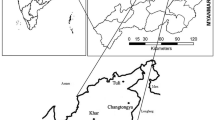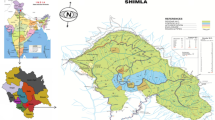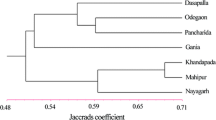Abstract
Tree species diversity, biovolume and forest stand structure were investigated in natural forest ecosystem located around some selected communities in the bitumen-producing area of Ondo state, Nigeria. Two forest reserves and four free areas distributed in 4 Local Government Areas (LGA) of the state were selected for data collection, out of the total 6 LGAs in the bitumen belt of the state. The two forest reserves are Oluwa FR at Legge in Odigbo LGA and Eba Island FR in Ese-Odo LGA while the four free areas are located close to each of Omotoso community (Odigbo LGA), Ode-Aye community (Okitipupa), Igbo-Egunrin community (Ilaje) and Igbotako community (Okitipupa). Eight plots of equal size (20 × 20 m) were located in each of the selected location, using systematic line transect sampling design. In each plot, all living trees with dbh ≥ 10 cm were identified with their botanical names and their dbhs were also measured. The results of the study reveal that there were ninety nine (99) tropical hardwood timber species (range: 21 to 48 species per selected forest). These species were distributed among twenty nine (29) families. While Funtumia elastica has the highest population distribution across the selected communities’ forest, Euphorbiaceae was the dominant family in the entire area. Although there was a moderate variation in the biodiversity indices among the selected communities’ forest, the Shannon-Weiner diversity index of H1 = 4.02 and species evenness of E = 0.88 were obtained for the entire study area. Tree density summing up to 2,740 trees/6 ha varied moderately, with a range of 361–609 tree/ha, among the communities. Though most of the trees encountered belonged to the lowest diameter size class, the mean basal area and biovolume were 26.69 m2/ha and 262.36 m3/ha respectively. Recommendations guiding the decision on the allocation of the communities’ forest to the bitumen exploratory industries are made and the need for good forest management of the prospective area of bitumen exploration of Ondo state is emphasized. This is to prevent the imminent loss of biological diversity that would eventually accompany the exploration.



Similar content being viewed by others
References
Adekunle VAJ, Akindele SO, Fuwape JA (2002) Impacts of over exploitation on biodiversity, yield and sustainable use of tropical rainforest ecosystem: a case study of Omo Forest reserve, Southwest Nigeria. In: Abu JE, Oni PI, Popoola L (eds) Forestry and challenges of sustainable livelihood. Proceeding of the 28th Annual Conference of the Forestry Association of Nigeria, Akure, Nigeria. 4th−8th Nov. 2002, pp 252–263
Adekunle VAJ (2005) Trends in forest reservation and biodiversity conservation in Nigeria. In: Okoko E, Adekunle VAJ, Adeduntan SA (eds) Environmental sustainability and conservation in Nigeria. Environmental conservation and research team, Federal University of Technology, Akure, pp 82–90
Adekunle VAJ (2006) Conservation of tree species diversity in tropical rainforest ecosystem of southwest Nigeria. J Trop For Sci 18(2):91–101
Adeyemo AI, Jegede G (2002) Effects of anthropogenic activities on Nigerian environment. In: Abu JE, Oni PI, Popoola L (eds) Forestry and challenges of sustainable livelihood. Proceeding of the 28th Annual Conference of the Forestry Association of Nigeria, Akure, Nigeria, 4th–8th Nov. 2002, pp 89–93
Akinyemi OD, Ugbogu OA, Adedokun D, Sefiu H, Odewo TK, Odofin BT, Ibidapo V (2002) A floristic study of Onigambari lowland rainforest reserve. In: Abu JE, Oni PI, Popoola L (eds) Forestry and challenges of sustainable livelihood. Proceeding of the 28th Annual Conference of the Forestry Association of Nigeria, Akure, 4th–8th Nov 2002, pp 346–357
Alder D Abayomi JO (1994) Assessment of data requirement for sustained yield calculations. A consultancy report prepared for the Nigerian Tropical Action Plan, FORMECU, Federal Department of forestry, Ibadan, May, 1994
Bhat DM, Naik MB, Patagar SG, Hedge GT, Kanade YG, Hedge GN, Shastri CM, Shetti DM, Furtado RM (2000) Forest dynamics in Tropical rainforests of Uttara Kannada district in Western Ghats, India. Curr Sci 79(7):975–989
Brashears MB, Fajvan MA, Schuler TM (2004) An assessment of canopy stratification and tree species diversity following clearcutting in Appalachian Hardwoods. For Sci 50(1):54–61
Cannon CH, Peart DR, Leighton M (1998) Science 281:1336–1368
CBD-UNEP (2005) Report of convention on biological diversity between 2001–2005
Coomes OT, Grimard F, Burt GJ (2000) Tropical forests and shifting cultivation: secondary forest dynamics among traditional farmers of the Peruvian Amazon. Ecol Econ 32:109–124
Dudley N, Stolton S (2002) In: Wicks C, Heap J, Jeanrenaud JP (eds) To dig or not to dig? A discussion paper for WWF on criteria for determining the suitability or acceptability of mineral exploration, extraction and transport form ecological and social perspectives. WWF International and WWF-UK, http://www.mineralresourcesforum.org/html. Cited 12th February, 2007
ENS (2003) Environmental News Services (ENS), Ghana
Gbile ZO (1984) Vernacular names of Nigerian Plants-Yoruba. Forestry research institute of Nigeria, Ibadan, Nigeria
Gillespie TW, Brock J, Wright CW (2004) Prospects for quantifying structure, floristic composition and species richness of tropical forests. Int J Remote Sens 25(4):707–771
Guo Y, Gong P, Amundson R (2003) Pedodiversity in the United States of America. Geoderma 117:99–115
Houghton JT, Meiro-Filho LG, Callandar BA, Harris N, Kattenberg A, Maskell K (1996) Climate change 1995: the science of climate change, Cambridge University Press, Cambridge
Isichei AO (1995) Omo biosphere reserve: current status, utilization of biological resources and sustainable management (Nigeria). UNESCO South-South cooperation programme working paper No.11, 48 pp
Kammesheidt L (2002) Perspectives on secondary forest management in tropical humid lowland America. Ambio 31:243–250
Keay RW J (1989) Trees of Nigeria. A revised version of “Nigeria Trees” (Keay et al. 1964). Clarendron Press, Oxford, 476 pp
Kent M, Coker P (1992) Vegetation description and analysis: a practical approach, Belhaven press, London, 363 pp
Lowe RG (1997) Volume increment of natural moist tropical forest in Nigeria. Comm For Rev 76(2):109–113
Margules CR, Pressey RL (2000) Systematic conservation planning. Nature 405:243–252
Nath PC, Arunchalam A, Khan ML, Arunchalam K, Bharbhuiya AR (2005) Vegetation analysis and tree population structure of tropical wet evergreen forests in and around Namdapha National Park, Northeast India. Biodivers Conserv 14:2109–2136
NEST (1991) Nigerian threatened environment. Nigerian environmental action/study team (NEST), Ibadan, 288 pp
OECD (2002) In: Guidelines for a native vegetation significant environmental benefit policy for the clearance of native vegetation associated with the minerals and petroleum industry. Prepared for the Native Vegetation Council, Australia, September 2005 30 pp
Olagbende OT (1997) Oil exploration, production and environmental management in Nigeria. In: Oduwaiye, EA, Obiaga PC Abu JE (eds), Proceedings of 24th Annual Conference of Forestry Association of Nigeria, Ibadan, pp 327–336
Onyekwelu JC, Adekunle AJ, Adeduntan SA (2005) Does tropical rainforest ecosystem possess the ability to recover from severe degradation? In: Popoola L, Mfon P, Oni PI (eds) Sustainable forest management in Nigeria: lessons and prospects. Proceeding of the 30th Annual Conference of the Forestry Association of Nigeria, Kaduna, 07th–11th Nov. 2005, pp 145–163
Parthasarathy N (2001) Changes in forest composition and structure in three sites of tropical evergreen forest around Sengaltheri, Western Ghats. Curr Sci 80(3):389–393
Phillips O, Martinez RV, Vargas PN, Monteagudo AL, Zans MEC, Sanchez WG, Cruz AP, Timana M, Yli-Halla M, Rose S (2003) Efficient plot-based floristic assessment of tropical forests. J Trop Ecol 19:629–645
Price PW (1997) Insect ecology, 3rd edn. Wiley, NY
Royal Society (2003) Measuring biodiversity for conservation. Royal society policy document, November 2003
Slik JWF, Poulsen AD, Ashton PS, Cannon CH, Eichhorn KAO, Kartawinata K, Lanniari I, Nagamasu H, Nakagawa M, van Nieuwstadt MGL, Payne J, Purwaningsih, Saridan A, Sidiyasa K, Verburg1 RW, Webb CO, Wilkie P (2003) A floristic analysis of the lowland dipterocarp forests of Borneo. J Biogeogr 30:1517–1531
Smith DN, Killeen TJ (1995) A comparison of the structure and composition of montane and lowland tropical forest in the Serranía Pilón Lajas, Beni, Bolivia, http://www.mobot.org. Cited 25th Jan 2007
SPSS (2003) Statistical package for social sciences, 10.0 for windows. SPSS Inc. Illinios, USA
Tilman D, Lehman C (2001) Human-caused environmental change: Impacts on plant diversity and evolution. PNAS 98(10):5433–5440
Verissimo A, Bareto P, Tarifa R, Uhl C (1995) Extraction of a high-value resource in Amazonia: the case of mahogany. For Ecol Manage 72:39–60
Were J L R (2001) Nigerian lowland forests (AT 0123), http://www.worldwildlife.org/wildlife/profiles/terrestrial/at/at0123_full.html. Cited 22nd Jan 2002
Author information
Authors and Affiliations
Corresponding author
Rights and permissions
About this article
Cite this article
Adekunle, V.A.J., Olagoke, A.O. Diversity and biovolume of tree species in natural forest ecosystem in the bitumen-producing area of ondo state, Nigeria: a baseline study. Biodivers Conserv 17, 2735–2755 (2008). https://doi.org/10.1007/s10531-007-9279-y
Received:
Accepted:
Published:
Issue Date:
DOI: https://doi.org/10.1007/s10531-007-9279-y




